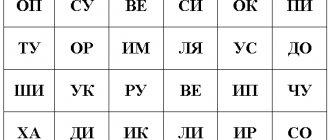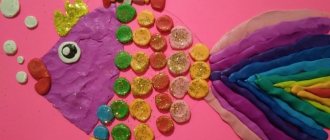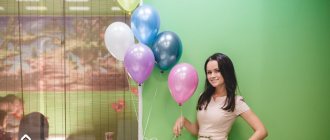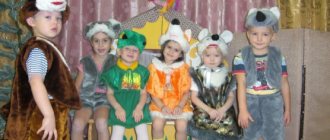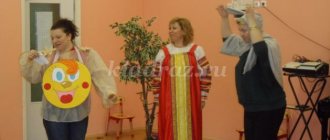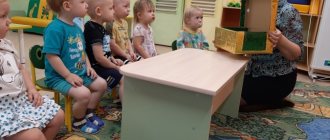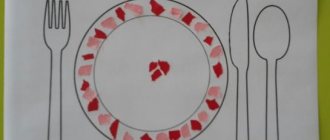Fairytale therapy for children 2-3
The peculiarity of psychological fairy tales for children under 3 years old lies in their general cognitive potential. By creating a fictitious story about a situation or problem related to a child, an adult can gently suggest a solution to this problem. Since fairy tales do not indicate or teach, but act unobtrusively, the therapeutic effect of their use is enormous. For example, lullabies help overcome sleep problems in hyperactive children.
In addition to correctional options, there is also developmental fairy tale therapy for children, which describes situations and actions that do not have a real implementation in life, but which can expand the child’s experience and, perhaps, be useful in the future.
We have selected for you examples of psychological stories for children 2-3 years old. To consolidate the result, it is better to use several methods at once: reading aloud, acting out with faces or toys, drawing based on a fairy tale.
The fairy tale about the Zvonkaya River is a joy for children who are often ill. Helps create the right psychological mood for a speedy recovery.
Once upon a time there was a river. Her name was Joy. She was a very kind, cheerful little river. Many different herbs and flowers always grew on its banks, squirrels came running to it every day to play and beautiful butterflies and dragonflies flew in. Goldfish and small pink crabs splashed in its clear, murmuring water.
And so they all lived cheerfully and playfully, until one day duckweed and dirt accidentally appeared among them from nowhere. It gradually filled the entire river. And this duckweed and mud made it harder for the stream to run. Less and less fresh, clean water found its way into our river, and it became increasingly difficult for the stream to breathe. The river stopped running so loudly and cheerfully. The water in it was filled with silt and algae, and the fish generally swam away, because... they had nothing to eat. The river became sad... And although the stream did not give up, and worked day and night, it could not defeat this swamp on its own.
The squirrels and butterflies ran to ask all the forest inhabitants for help, maybe someone knows how to help our River and return it to its former freshness and joy, to help the stream breathe easily and fully again.
And finally, the Wise Owl told them what to do.
Only the Wind can defeat this duckweed. It is necessary to blow up all the silt, dirt and wood chips, and then the stream will wash it away and the River will be able to fill with fresh water again.
The wind heard this and immediately rushed to the rescue, because he and Joy were good friends. More than once he flew here to play hide and seek or rustle the leaves. And so he immediately got to work. He blew, and blew, and blew... harder and harder, then he gained strength and blew again as hard as he could. So he spent the whole day, blowing as hard as possible, for as long as possible - and the duckweed went away, the silt dissipated, the chips floated far, far away. And in the end, the water cleared so much that the stream was able to move this dirt from its throat, and clean, fresh water flowed again!
The river cleared and began to gurgle again with all the sounds of music, the water became clear, cool, and ringing. And immediately the goldfish and pink crabs returned home, the dragonflies and butterflies sparkled with their wings, and everything became as before. The Joy River could again have fun with friends and flow wherever it wanted. She felt light and free.
Only the river remembered how hard it was for it to be sick and to be a swamp, to stand motionless, full of silt. Therefore, she asked her friend Wind to visit her every day in the morning and evening, to blow for at least 15 minutes, just in case, so that no more dirt and duckweed could prevent the stream from breathing freely and sharing water with our river Joy. And so the wind blew, and the river cordially thanked it with its ringing murmur, and the silt never appeared next to it again.
A fairy tale about a bear cub who didn’t want to go to kindergarten - a story from child psychologist Alexandra Bondarenko for children who are about to start going to kindergarten.
Once upon a time there lived a bear cub named Alirik. He had a papa bear and a mama bear. They lived amicably and cheerfully. Mama bear played a lot with Alirik, fed him, and walked with him. Papa Bear built houses with him from blocks and told him various interesting stories. Alirik the bear was always with his parents, and they were with him. They felt like one whole, like a flower with its petals, stem and leaves.
Alirik grew and became bigger. Now he knew how to do a lot himself: eat, drive a car, put on shoes. Then the parents decided that Alirik was already old enough to go to classes with the wise Owl.
And then, one fine day, mother bear took Alirik to Owl for classes. It didn’t take long to go there, but it was fun, because mom told me a lot of interesting things along the way: where the birds build their nests, why the grass grows upward, where the ants run.
When they came to Owl, Alirik realized that now he would have to part with his mother. Even if it won’t be for long, she won’t be around. Alirik felt very sad. But at this time he heard laughter in the group. He wondered: who laughs like that and why? Alirik boldly took Owl by the hand and went to the other children.
In the evening, mother bear returned to pick up Alirik. He happily ran up to his mother and hugged her. He wanted to tell her so much: how they played, and how they sang songs, and how the Owl talked about forest dwellers, and many other interesting things.
Now Alirik was having fun parting with his mom and dad. He knew that they would always return and he could tell them about new experiences. They don’t go to the wise Owl!
Purpose of the program.
Prevention and elimination of deviations in behavior, development of the emotional-volitional sphere, arbitrariness of mental processes caused by delayed mental development; creating a basis for successful mastery of general education programs. The objectives are:
- expanding and deepening children's knowledge about the world around them;
- development of the emotional-volitional sphere;
- development of a sense of collectivism, responsibility for each other, formation of experience of moral behavior;
- development of independence, self-control;
- development of communication skills;
- development of various analyzers: visual, auditory, speech motor, kinesthetic;
- correction of deviant behavior;
- development of emotional and motor adequacy;
Program content:
The program is divided into blocks: In 1st grade: 1 block - Diagnostic (1 hour 40 minutes) 2 block - Corrective and developmental (18 hours) 3 block - Diagnostic (1 hour 40 minutes). In 2nd grade: 1st block – Diagnostic (1 hour 10 min) 2nd block – Correctional and developmental (9 hours). Block 3 – Diagnostic (1 hour 10 min)
In grades 3 – 4: 1 block – Diagnostic (1 hour) 2 block – Correctional and developmental (15 hours).
Block 3 - Diagnostic (1 hour) Structure of a correctional and developmental fairytale therapy lesson using elements of ART therapy:
- The mood for the upcoming activity. Warm up. Collective exercises.
- Repetition. The presenter asks the children a question about what they remember from the last lesson.
- Extension. The presenter tells or shows the children a new fairy tale. Invites children to try, help some creature from a fairy tale, come up with their own ending to a fairy tale, draw their favorite plot from a fairy tale (or a continuation).
- Consolidation. The presenter conducts games that allow children to gain new experience; symbolic journeys and transformations take place. Discussion of something invented (drawn by children)
- Integration. The facilitator discusses and analyzes with the children in what situations in life they can use the experience that they have acquired.
- Summary. The presenter sums up the lesson. He clearly states the sequence of what happened in the lesson, recognizes individual children for their merits, and emphasizes the significance of the experience gained.
- Ritual of “exit” from a fairy tale. Repeating the ritual of “entering” a lesson with an addition.
Fairytale therapy classes are conducted in grades 1-2 as part of a comprehensive program of student support by s/c specialists , and in grades 3-4 as independent classes by a teacher-psychologist with students with disabilities. In the first and second grades, students of one class are divided into 3 subgroups of 4 people each. The duration of one lesson in each subgroup is 20 minutes. There are 2 classes per week for each subgroup. In the third and fourth grades, children are also divided into subgroups, the duration of the lesson increases in each subgroup to 30 minutes. One lesson per week is held with each subgroup. Techniques aimed at developing the emotional-volitional sphere, the child’s self-confidence, social behavior skills: continuation of the theme of a fairy tale read by children;
performing in front of other children; discussion of the behavior of the characters and independent choice of motivation (I would do this...). When organizing correctional and developmental activities, the following principles are taken into account : The principle of consistency.
Child development is a process in which all components are interconnected, interdependent and interdependent. You cannot develop just one function; systematic work on the development of the child is necessary. The principle of concentrism. Concentrated arrangement of educational material, which is located within one lexical topic, regardless of the type of activity. The principle of compliance with age and individual capabilities. An individual program of work with a child should be built in accordance with the psychophysiological patterns of age-related development, taking into account risk factors. The principle of adequacy of the requirements and loads imposed on the child during classes helps to optimize classes and increase efficiency and provides support for functions that do not have deficiencies, while simultaneously “pulling up” deficient functions. The principle of gradualism and consistency, moving from simple and accessible tasks to more complex, complex ones. The principle of individualizing the pace of work is the transition to a new stage of training only after complete mastery of the material of the previous stage. The principle of communication. Training is organized in natural communication conditions or as close as possible to them. The principle of collectivism. Conditions are created for the active work of all children in the group. The principle of visibility. Training is based on specific images that are directly perceived by students. The principle of developmental education. Accounting for the zone of proximal development. The principle of unity of diagnosis and correction. Correction is carried out based on the results of the diagnostics. The principle of taking into account the relationship between the primary disorder and secondary deviations in the development of the child.
<<Program for behavior correction, EMU, communication using fairy tale therapy and elements of ART therapy>> NEXT —>
